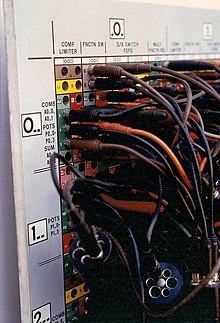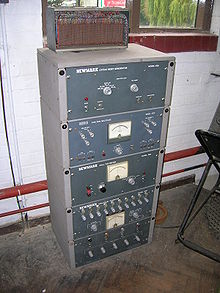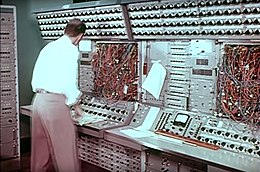Electronic analog computers

Electronic analog computers typically have front panels with numerous jacks (single-contact sockets) that permit patch cords (flexible wires with plugs at both ends) to create the interconnections that define the problem setup. In addition, there are precision high-resolution potentiometers (variable resistors) for setting up (and, when needed, varying) scale factors. In addition, there is usually a zero-center analog pointer-type meter for modest-accuracy voltage measurement. Stable, accurate voltage sources provide known magnitudes.
Typical electronic analog computers contain anywhere from a few to a hundred or more operational amplifiers ("op amps"), named because they perform mathematical operations. Op amps are a particular type of feedback amplifier with very high gain and stable input (low and stable offset). They are always used with precision feedback components that, in operation, all but cancel out the currents arriving from input components. The majority of op amps in a representative setup are summing amplifiers, which add and subtract analog voltages, providing the result at their output jacks. As well, op amps with capacitor feedback are usually included in a setup; they integrate the sum of their inputs with respect to time.
Integrating with respect to another variable is the nearly exclusive province of mechanical analog integrators; it is almost never done in electronic analog computers. However, given that a problem solution does not change with time, time can serve as one of the variables.
Other computing elements include analog multipliers, nonlinear function generators, and analog comparators.
Electrical elements such as inductors and capacitors used in electrical analog computers had to be carefully manufactured to reduce non-ideal effects. For example, in the construction of AC power network analyzers, one motive for using higher frequencies for the calculator (instead of the actual power frequency) was that higher-quality inductors could be more easily made. Many general-purpose analog computers avoided the use of inductors entirely, re-casting the problem in a form that could be solved using only resistive and capacitive elements, since high-quality capacitors are relatively easy to make.
The use of electrical properties in analog computers means that calculations are normally performed in real time (or faster), at a speed determined mostly by the frequency response of the operational amplifiers and other computing elements. In the history of electronic analog computers, there were some special high-speed types.
Nonlinear functions and calculations can be constructed to a limited precision (three or four digits) by designing function generators—special circuits of various combinations of resistors and diodes to provide the nonlinearity. Typically, as the input voltage increases, progressively more diodes conduct.
When compensated for temperature, the forward voltage drop of a transistor's base-emitter junction can provide a usably accurate logarithmic or exponential function. Op amps scale the output voltage so that it is usable with the rest of the computer.
Any physical process that models some computation can be interpreted as an analog computer. Some examples, invented for the purpose of illustrating the concept of analog computation, include using a bundle of spaghetti as a model of sorting numbers; a board, a set of nails, and a rubber band as a model of finding the convex hull of a set of points; and strings tied together as a model of finding the shortest path in a network. These are all described in Dewdney (1984).
Components

Analog computers often have a complicated framework, but they have, at their core, a set of key components that perform the calculations. The operator manipulates these through the computer's framework.
Key hydraulic components might include pipes, valves and containers.
Key mechanical components might include rotating shafts for carrying data within the computer, miter gear differentials, disc/ball/roller integrators, cams (2-D and 3-D), mechanical resolvers and multipliers, and torque servos.
Key electrical/electronic components might include:
- precision resistors and capacitors
- operational amplifiers
- multipliers
- potentiometers
- fixed-function generators
The core mathematical operations used in an electric analog computer are:
- addition
- integration with respect to time
- inversion
- multiplication
- exponentiation
- logarithm
- division
In some analog computer designs, multiplication is much preferred to division. Division is carried out with a multiplier in the feedback path of an Operational Amplifier.
Differentiation with respect to time is not frequently used, and in practice is avoided by redefining the problem when possible. It corresponds in the frequency domain to a high-pass filter, which means that high-frequency noise is amplified; differentiation also risks instability.
Limitations
In general, analog computers are limited by non-ideal effects. An analog signal is composed of four basic components: DC and AC magnitudes, frequency, and phase. The real limits of range on these characteristics limit analog computers. Some of these limits include the operational amplifier offset, finite gain, and frequency response, noise floor, non-linearities, temperature coefficient, and parasitic effects within semiconductor devices. For commercially available electronic components, ranges of these aspects of input and output signals are always figures of merit.
Decline
In the 1950s to 1970s, digital computers based on first vacuum tubes, transistors, integrated circuits and then micro-processors became more economical and precise. This led digital computers to largely replace analog computers. Even so, some research in analog computation is still being done. A few universities still use analog computers to teach control system theory. The American company Comdyna manufactured small analog computers.[40] At Indiana University Bloomington, Jonathan Mills has developed the Extended Analog Computer based on sampling voltages in a foam sheet.[41] At the Harvard Robotics Laboratory,[42] analog computation is a research topic. Lyric Semiconductor's error correction circuits use analog probabilistic signals. Slide rules are still popular among aircraft personnel.[citation needed]
Resurgence
With the development of very-large-scale integration (VLSI) technology, Yannis Tsividis' group at Columbia University has been revisiting analog/hybrid computers design in standard CMOS process. Two VLSI chips have been developed, an 80th-order analog computer (250 nm) by Glenn Cowan[43] in 2005[44] and a 4th-order hybrid computer (65 nm) developed by Ning Guo in 2015,[45] both targeting at energy-efficient ODE/PDE applications. Glenn's chip contains 16 macros, in which there are 25 analog computing blocks, namely integrators, multipliers, fanouts, few nonlinear blocks. Ning's chip contains one macro block, in which there are 26 computing blocks including integrators, multipliers, fanouts, ADCs, SRAMs and DACs. Arbitrary nonlinear function generation is made possible by the ADC+SRAM+DAC chain, where the SRAM block stores the nonlinear function data. The experiments from the related publications revealed that VLSI analog/hybrid computers demonstrated about 1–2 orders magnitude of advantage in both solution time and energy while achieving accuracy within 5%, which points to the promise of using analog/hybrid computing techniques in the area of energy-efficient approximate computing.[citation needed] In 2016, a team of researchers developed a compiler to solve differential equations using analog circuits.[46]
Analog computers are also used in neuromorphic computing, and in 2021 a group of researchers have shown that a specific type of artificial neural network called a spiking neural network was able to work with analog neuromorphic computers.[47]
Practical examples

These are examples of analog computers that have been constructed or practically used:
- Boeing B-29 Superfortress Central Fire Control System
- Deltar
- E6B flight computer
- Kerrison Predictor
- Leonardo Torres y Quevedo's Analogue Calculating Machines based on "fusee sans fin"
- Librascope, aircraft weight and balance computer
- Mechanical computer
- Mechanical watch
- Mechanical integrators, for example, the planimeter
- Nomogram
- Norden bombsight
- Rangekeeper, and related fire control computers
- Scanimate
- Torpedo Data Computer
- Torquetum
- Water integrator
- MONIAC, economic modelling
- Ishiguro Storm Surge Computer
Analog (audio) synthesizers can also be viewed as a form of analog computer, and their technology was originally based in part on electronic analog computer technology. The ARP 2600's Ring Modulator was actually a moderate-accuracy analog multiplier.
The Simulation Council (or Simulations Council) was an association of analog computer users in US. It is now known as The Society for Modeling and Simulation International. The Simulation Council newsletters from 1952 to 1963 are available online and show the concerns and technologies at the time, and the common use of analog computers for missilry.[48]




No comments:
Post a Comment